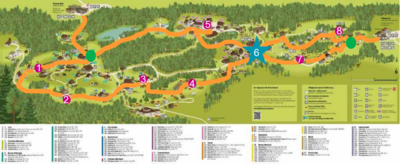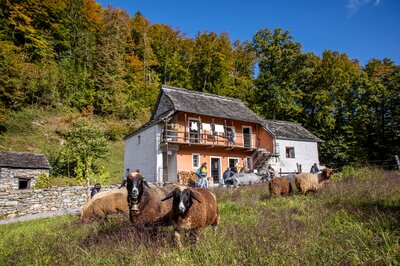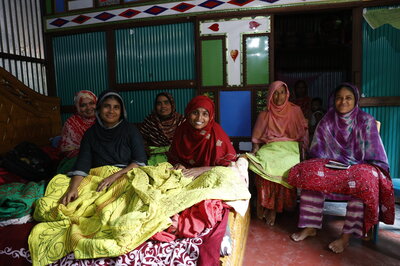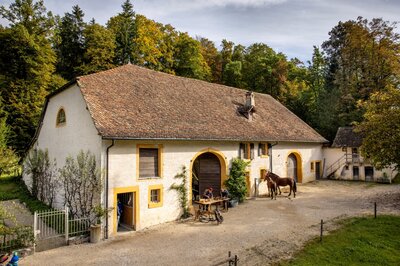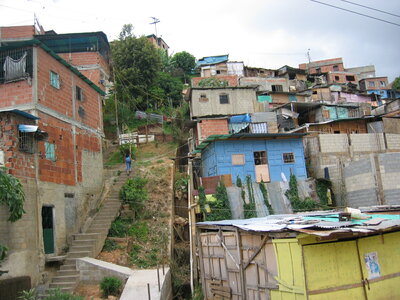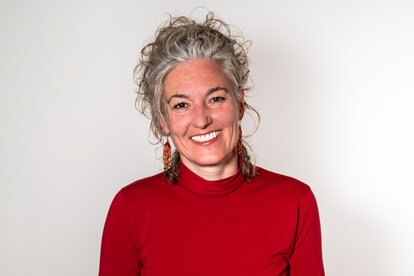You might think that the world at the Ballenberg Open-Air Museum has stood still for centuries. But appearances are deceptive: emigration and immigration, finding seasonal work elsewhere, or simply being on the move are and have always been global phenomena. Phenomena that can also be found at Ballenberg. Together with the development organization Helvetas, Ballenberg is looking beyond its own setting and focusing on the world. The 2024 annual theme tells stories of people on the move along a themed trail: locally and globally, yesterday and today.
When: April 11 - October 27, 2024
Where: Ballenberg Open-Air Museum
What: Themed trail with stations in seven different Ballenberg houses, a large central installation and many interactive elements
Who: For anyone who is curious and out and about on the Ballenberg
Stories of departure and arrival
The historical world of Switzerland, as shown by the Ballenberg Open-Air Museum, was much more mobile and characterized by global influences than its image suggests. Both in the past and today, being on the move was a common, worldwide phenomenon. The Ballenberg and Helvetas show together that historical narratives and contemporary stories can also be used to draw fascinating comparisons.
The theme trail
The themed trail extends over seven exhibition stations in historic houses. Inside the houses, the public encounters stories of people from that particular house or region. Helvetas also presents the story of a person living today from one of Helvetas' many partner countries. In this way, six historical and seven contemporary stories come together.
The stories
The portraits of the people are exemplary stories that illustrate a basic principle. They describe positive experiences and opportunities that arise from migration, but also difficulties and limitations. They are all thought-provoking.
Nomadism and alpine farming, seasonal work, stays abroad for educational purposes, emigration overseas due to poverty and a lack of prospects, flight and expulsion, or the center of life shifting through marriage; all are people who set off both voluntarily and involuntarily because they saw an opportunity for themselves and their family or because staying was a very bad option. The reasons were as varied in the past as they are today. What they all have in common is the hope of a better life.
Get to know some of the people portrayed by Helvetas.
Reason for migration «Work & Poverty»
Most people travel around the world because they are looking for work and sufficient income opportunities. This was the case both in historical Switzerland and today.
Historically - Switzerland
Like many of his Ticino compatriots, Giuseppe Giulieri emigrated to the USA in 1910. Poor harvests and disease forced many family fathers to seek work abroad. His three brothers also left Cugnasco. Giuseppe Giulieri returned to Ticino in his old age. It has hardly changed at all. Most of the people still live off agriculture. Although emigration for work provided those who stayed behind with a modest income, the region lost workers and the will to change. Giuseppe Giulieri questioned his decision. And he misses his son, who followed in his father's footsteps and emigrated to the USA.
Contemporary - International
In Bangladesh today, some of the reasons why people leave their country are comparable to those in historic Switzerland in the 19th century: The division of land ownership through inheritance, too few jobs and ecological crises are causing many young Bangladeshis to emigrate to the Gulf States, where there is a shortage of labor. Unlike in the past, many people today are more self-determined, more internationally networked and have more information. Nevertheless, they often lack the right information to prevent abuse and exploitation. Many people take out loans with very high interest rates to leave the country. Abdul Akter from Bangladesh talks about his experiences.
Reason for migration «Education»
To benefit from good training or further education, people set off to explore new shores in other cities or countries. Those who have this opportunity are usually somewhat better off.
Historic - Switzerland
Joseph Guillerme (1796) once lived in Lancy (VD) on the Ballenberg. He was a well-traveled man. The wealthy farmer specialized in fruit growing. He went abroad to further his education, spending time in Pomerania (Prussia), The Hague (Netherlands) and Paris (France). He returned and settled down with the purchase of the "Les Avanchis" estate in Lancy. Here he started a family and applied what he had learned abroad in Switzerland: He introduced fruit espalier cultivation in this country.
Contemporary - international
In Venezuela, which has been in a serious crisis since 2013, one's level of education can also be a decisive factor for emigration.
Doctor Aixa Cayupare Dasilva emigrated from Venezuela with her husband, Jorge, in 2018 and went to Peru. They hoped for a better future for themselves and their children there. But Jorge died of Covid in 2020. For Aixa, a difficult time began in which she had to keep herself and her children afloat. She tells her story and what helped her to get back on her feet.
More stories from our protoganists and their reasons for migrating
Dialog venues
Despite geographical or temporal distance, everyone who visits the open-air museum can immerse themselves in the personal stories and compare them with their own experiences. On benches and tables in the grounds, places for dialog are created to encourage people to talk to each other. Questions of belonging affect us all:
- How often have we said goodbye and found our feet again?
- What places do we feel connected to other than where we currently live?
- Which people do we miss?
- Where do those with whom we have the closest contact live?
Everyone is invited to talk about their own roots, migratory movements and migration experiences and to find out what decisions each person makes as they go through life.
Installation in the center of the site with background information
In the center of the museum, there is a central location with activities and offers for sharing one's own opinions and experiences. In addition to the stories, background information and facts about migration and mobility are provided. In-depth background information can be accessed via QR code.
With a quiz, we put our own personal migration experiences in context with those of other visitors and in the context of historical and global mobility.
Calendar of events
-
Saturday, April 13, 2024
Official opening of the themed trail: The trail is hiked by project employees and the opening is celebrated with refreshments at the end. -
Sunday, May 19, 2024
International Museum Day: A Sunday dedicated to the annual theme of "on the move around the world." Personal guided tours enliven the stations of the themed trail. -
Saturday, September 7 and Sunday, September 8, 2024
European Heritage Days under the title "Networked." Life paths traverse the courtyard in a symbolic hands-on activity. In personal conversations, six people tell us migration stories from all over the world. The EcoArtLab of the HKB (BFH) in cooperation with the mLAB (UniBE) will present the results of the residency taking place at Ballenberg and guided tours will explain the Novazzano building and its networks.
Collaboration with the Bern University of the Arts (HKB)
The EcoArtLab of the Bern University of the Arts (BFH) in cooperation with the mLAB of the Institute of Geography at the University of Bern are guests of Helvetas. They will present at Ballenberg on the topics of climate change, migration and injustice. A residency has been advertised for this purpose: An artist and a scientist will work and live at Ballenberg during the 2024 season. During the summer, they will present their scientific findings to visitors in artistic form.
The Venue Ballenberg
Thanks to its central location, the Ballenberg Open-Air Museum can be reached quickly and easily from all directions.
Public transportation
Rail travelers take the Zentralbahn from Interlaken or Lucerne directly to Brienz or the Brünig Pass. A regular bus service runs from Brienz and Brünig railroad stations to the Ballenberg West and Ballenberg East entrances.
Timetables
Car / Bus
GPS / Google Maps
Your contact person for «on the move across the world»
Our past exhibitions
Helvetas exhibitions show connections between Switzerland and developing countries in an interactive way. They provide inspiration on how you can contribute to a sustainable and just world and are shown in Swiss and Liechtenstein museums.


